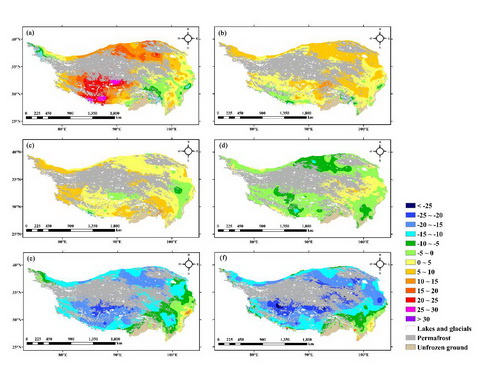Scientists Evaluate Freeze-Thaw Changes of Seasonally Frozen Ground on the Tibetan Plateau
Updatetime:2021-01-04From:
【Enlarge】【Reduce】
Seasonally frozen ground (SFG) plays important roles in local and global circulation, climate, hydrology, and terrestrial ecosystems through its influence on surface energy, water and carbon cycles in the earth system. Therefore, the freeze-thaw change of SFG is usually seen as an important indicator of climate change. However, the historical distribution and changes of SFG on the Tibetan Plateau (TP) have received little attention.
Based on observed daily freeze depth of SFG from meteorological stations on the TP from 1960 to 2014, scientists from the Northwest Institute of Eco-Environment and Resources (NIEER) of Chinese Academy of Sciences (CAS) analyzed the spatial-temporal characteristics and trends in SFG and explored the relationships between them and climatic and geographical factors. Furthermore, freeze-thaw changes of SFG on a regional scale were also assessed.
This study showed that multi-year mean maximum freeze depth, freeze-thaw duration, freeze start date, and thaw end date demonstrated obvious distribution characteristics of climatic zones. A decreasing trend in maximum freeze depth and freeze-thaw duration occurred on the TP from 1960 to 2014.
The study indicated that freeze-thaw changes of SFG significantly affected by soil hydrothermal conditions on the TP could be assessed by elevation and latitude or by air temperature and precipitation. The regional average of maximum freeze depth and freeze-thaw duration caused by climatic and geographical factors were larger than those averaged using meteorological station data because most stations are located at lower altitudes.
Besides, the study also showed that maximum freeze depth and freeze-thaw duration have decreased sharply since 2000 on the entire TP. Warming and wetting conditions of the soil resulted in a significant decrease in maximum freeze depth and freeze-thaw duration in the most area of the TP, while drying soil result in a slightly increase of them in the southeast of the TP.
This study has been published in Journal of Climate in an article entitled “Freeze–Thaw Changes of Seasonally Frozen Ground on the Tibetan Plateau from 1960 to 2014”.

Spatial variability of the maximum freeze depth anomaly for the 1960s (a), 1970s (b), 1980s (c), 1990s (d), 2000s (e), and 2010s (f), with respect to the 1960–2014 mean across the TP. (Image by Prof. LUO's group)
Contact:
LUO Siqiong
E-mail: lsq@lzb.ac.cn
Key Laboratory of Land Surface Process and Climate Change in Cold and Arid Regions, Northwest Institute of Eco-Environment and Resources, Chinese Academy of Sciences, Lanzhou 730000, China.
Appendix




